Laura Dern Is Our Only Hope For Bringing David Lynch Back
by Seth Colter Walls
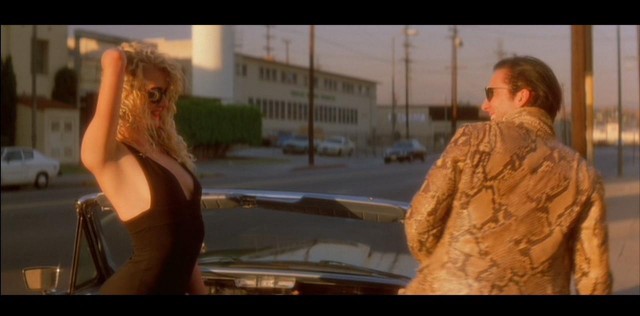
The first in a series on collaborations that we now take for granted but initially made little sense.
Fans of David Lynch are accustomed, by now, to the half-decade wait. It took five years after Twin Peaks: Fire Walk With Me unjustly bombed out of theaters in 1992 before we received Lost Highway. Later, once Mulholland Drive completed its strange, tortured path to realization — from stillborn network teevee pilot for ABC to a New York Film Festival premiere! — Lynch’s IMDB page indulged another similar gap when it came to feature-length projects. That streak of inactivity was only broken when INLAND EMPIRE smeared its digital abstractions and idiosyncratic willfulness (all-caps title included) across screens on the festival circuit.
Now we’re five years on since that work — and we haven’t heard a whisper of a rumor about a new film. During Lynch’s last five-year-itch interregnum, there was at least a sliver of web-based innovation to tide us over; if he couldn’t find funding for features, Lynch could be depended on to produce a goofy, Flash-animated series for his website. This time, the filmmaking lag has been filled up with campaigns on behalf of transcendental meditation, homespun coffee branding and, yes, that dance album slated for a Nov. 8 release.
Given this, it was far from weird for anyone to have wondered whether Lynch had unofficially quit the cinema. Then, earlier this month, Abel Ferrara went and made it ever so slightly more official, in an interview with IndieWire. “[David] Lynch doesn’t even want to make films anymore,” Ferrara said, while ranting about how his generation of directors had lost the plot. “I’ve talked to him about it, OK? I can tell when he talks about it. I’m a lunatic, and he’s pushing transcendental meditation.”
It’s easy to imagine a group of cineastes organizing in response to this news, with the hopes of dreaming up the contours of a lobbying campaign that might get Lynch thinking about movies again. Though, without Laura Dern on board, any such campaign would probably be pointless. The story of Lynch’s career can be told in large part through his various collaborations — think Kyle MacLachlan’s brilliant-naif detectives, Jack Nance’s furrowed-brow weirdos, or Angelo Badalamenti’s soundtracks, pitching back and forth between pop smooches and synths of doom — but Dern’s contribution to his career is as unequaled as it is unsung. She not only gets him, she’s helped him get why he cares about the non-painterly aspects of moviemaking, like story and character.
Though she appears in only three of his features, Dern has worked in every decade of Lynch’s activity but one (the ‘70s), and at every stage of his career (save film school). At the same time, Dern has offered Lynch a dramatic range that no other actor in his company can touch. For a writer so often resistant to traditional storytelling structures — as well as one who sometimes reveals, ahem, a limited approach to female characterization — Dern’s dramatic flexibility and radical alertness to shadings of performance have saved Lynch’s ass once or twice, and educated it in the process.
***
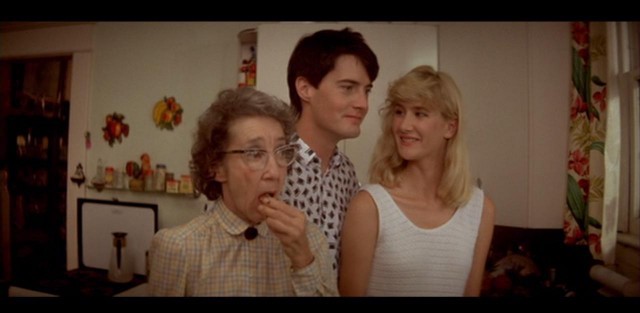
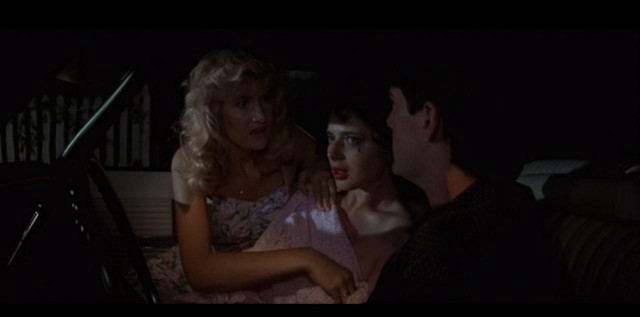
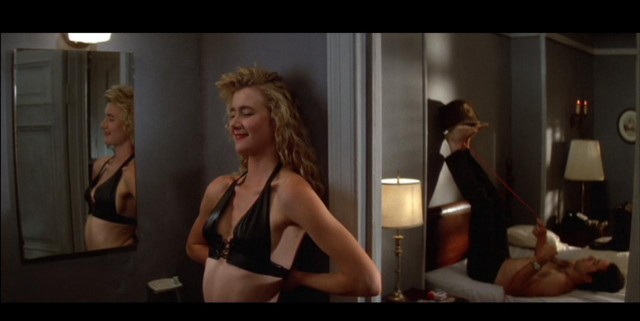
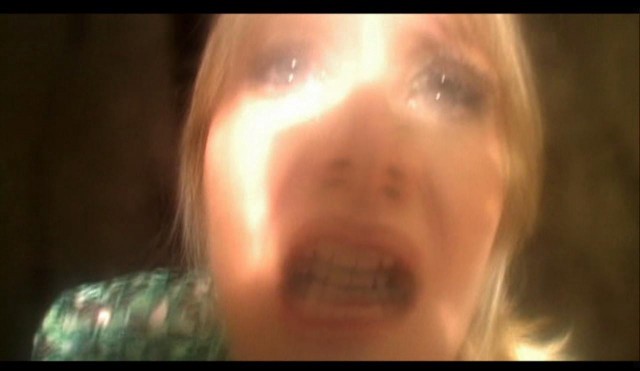
Feminist critiques of Lynch’s work can point toward not just the ritual degradation and sexual violence visited upon the likes of Dorothy Vallens and Laura Palmer, but how unknowable these characters can remain, despite all the trials we see them endure. “Twin Peaks” was a drama about the few thousand different ways a raped and murdered high-school homecoming queen was perceived in a town of a few thousand residents. A fair enough lens on small-town life, taken by itself. (And again, Fire Walk With Me balances out the TV show’s approach and concerns — you should watch it, though only after you’ve taken in the whole series!) But if too many of these women turn out to be ciphers, we might eventually begin to identify a blind side in the filmmaker’s field of vision.
Who exactly is Patricia Arquette in Lost Highway, anyway? More to the point: does Lost Highway direct us to think that the answer to this question is at all important? It doesn’t matter whether she’s a mysterious and chilly brunette housewife or a blonde-bombshell porno actress: Arquette is so pulchritudinously Other she’ll make a man’s head go into meltdown mode, literally (what with Bill Pullman’s skull dissolving down to the brain cavity and building itself back up as Balthazar Getty). It’s as if the movie is telling us some women are too hot to ever be known. Better to become an entirely new man after messing with that kind of femininity-as-weapon.
Dern has never fallen into this trap in a Lynch movie, even when playing a sex kitten. Barry Gifford’s source novel, Wild at Heart, conceived of Lula Pace Fortune as a sexual being, but Laura Dern rendered that trait on-screen in such a way that her straightforward experience of ecstasy would not overwhelm the other aspects of being an adult in the world. Dern’s Lula doesn’t just get to enjoy the highest ratio of orgasms to assaults in the entire Lynch universe, she still possesses a working facility for empathy — be it when comforting a not-long-for-this world victim of highway carnage, or when she just wants Nicholas Cage’s Sailor Ripley to switch off the damned, death-obsessed news already.
Dern got the movie’s operatic, titular line: “This whole world is wild at heart and weird on top.” That the line is delivered during one of the few mature adult conversations between lovers in a Lynch movie isn’t an accident, either. While it’s a big, over-the-top moment, emotive in a soap-opera fashion, Dern also makes it communicate dramatically, as her despair in this scene makes Sailor’s forthcoming attempts at problem-solving understandable, even if they aren’t particularly advisable.
In Blue Velvet, it’s also up to Dern to carry the film’s riskiest emotional moment, when she delivers her “dream of the robins” speech to MacLachlan’s Jeffery Beaumont. In that scene, the snarky opportunity for audience laughter comes with MacLachlan’s cheese-faced reaction to Dern’s idealism. But her conception of a perfect world — a vision held out to counteract the film’s darkest, Dennis Hopper-on-nitrous depths — needs to seem something other than just risible. And selling that quality is all up to Dern; just as it’s up to her to nudge the audience to accept Jeffrey’s spy-boy antics, when she says she’s not sure if he’s a detective or a pervert (while subtly suggesting that it might be okay with her if it turns out that he’s got some pervert in him). Dern’s Sandy might seem virginal compared to Isabella Rosselini’s Dorothy, and she might even be shocked to learn that her college-boy crush put “his disease” in the lounge singer, but even that’s not so disappointing a revelation that Sandy won’t rush to aid the other woman when she’s naked and covered in bruises. In these movies, Laura Dern is always down for some real grown-up behavior, be it moral or erotic.
***
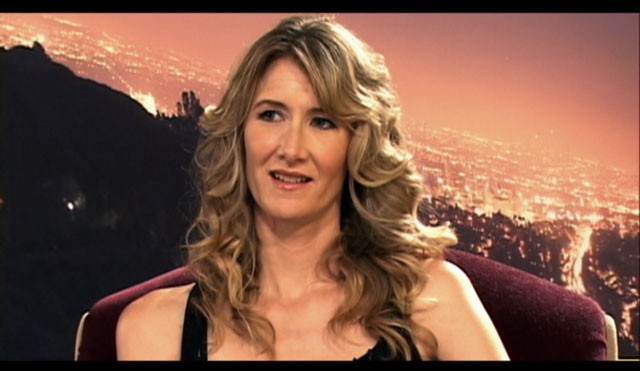
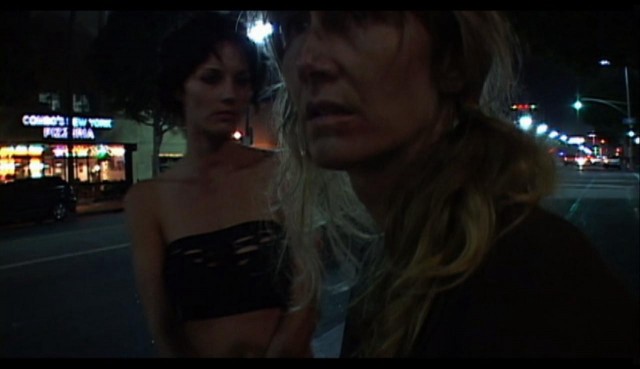
Aside from her bravery and flexibility in front of Lynch’s camera, it’s impossible not to acknowledge Dern’s similar steadfastness behind the scenes. The director gave her co-producer credit on INLAND EMPIRE for more than sentimental reasons; Dern’s forbearance over a multi-year period of staggered shooting was the only thing that made his three-hour fever dream possible in the first place. (It seems likely that Dern passed on at least some higher-paying work so she could remain on call for Lynch during this time.) “Every time he got an idea for a scene, we would shoot it, and he wrote the script through the course of this time,” Dern told reporters upon the film’s release.
While it’s difficult to speak super-definitively about what happens in INLAND EMPIRE, even after one has written out a lengthy, Wikipedia-style summary of its scenes, the film’s detractors ought to concede that, to whatever degree it all hangs together, it does so because of Dern. Does she read on the screen, during her early scenes, like an A-list movie star who is winning at the game of Hollywood, even if she’s being shot on consumer-grade digital video? Yup. Does she howl with the best of avant-cinema’s most tortured souls, whilst being chased down L.A.’s Skid Row streets at dawn by an angry passel of ladies of the night? Of course she does.
Dern seduces, and Dern repels; her character in INLAND EMPIRE frolics wildly under the covers while forgetting whether she’s playing a character in the movie-within-a-movie or if she’s just being herself. But through all this, Dern roots Lynch’s flights of abstraction in behaviors — most often derived out of fear — that feel recognizable to us. Only she can save Lynch’s three-hour abstraction from fully losing its own mind, its identity as a movie — and he knows, it, too. Even though there is no “dream of the robins” speech or “wild at heart and weird on top” movie-summing-up aria for Dern to sing, she’s still called upon to identify and resolve the movie’s central tension: It’s only when Dern walks into the strange room where a woman has been trapped, watching part of INLAND EMPIRE on a television, that the imprisoned viewer (and real-life audience) is granted an escape from whatever spectral demons have been haunting our viewing.
After working equally well with Lynch in his early, indie-style ascent, his mainstream pop period and now during his late-career explosion of his own practice, Dern’s qualifications for inspiring the director to try something new are beyond unique. Assuming Abel Ferrara’s perception of reality is correct (not always a given with self-described “lunatics”), and Lynch thinks he’s done with movies, here’s hoping Dern is already hard at work persuading Lynch that other creative possibilities still lie beyond the dance floor.
Seth Colter Walls writes for lots of places, including his Tumblr.
